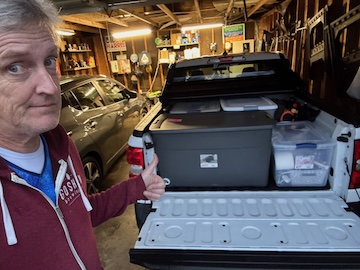Neither a Silver Bullet Nor a Werewolf (or both)

My first car was technically a 1968 Chevy Biscayne, with that “three on the tree” for its manual column shifter. It had multiple shades of green and silver, steered like a boat, and was as far from sleek as you can imagine. After college, though, I bought my first brand-new car: a 1988 Ford Festiva L. The “L,” I found out, meant “limited”— ”God’s” air conditioning, four on the floor, and an AM/FM radio, to be precise. I decked it out with Sparkomatic speakers and a Radio Shack tape deck that didn’t quite fit but worked anyway. It was perfect for delivering checks by day and pizzas by night during that Napa Valley summer of 1988.
Over the years, there were other cars: a memorable 1993 Ford Escort wagon with a perpetually failing muffler that announced my arrival from five blocks away. Now, in my later years, I’ve finally bought the vehicle I’ve been eyeing for two years: a white Ford Maverick Hybrid. It’s practical, efficient, and—being a hybrid—perhaps a bit of an ethical or political statement.
Since I started driving it, I’ve noticed every white truck on the road. Specifically, I high-five other white Mavericks through my window. It’s fascinating how once you’re tuned into something new, you start seeing it everywhere. This kind of attentional bias (perhaps frequency illusion bias) applies to many areas of life, including education and technology.
Seeing What’s New Everywhere
Generative AI, much like my white Maverick, is everywhere. It’s dominating conversations in education, particularly in English classrooms. We’ve been here before, though. In the early days of the internet, encyclopedias, and even Google, educators expressed similar fears. Back then, we worried students would merely copy text from these newfangled tools rather than think critically or creatively.
But those tools didn’t end writing or creativity. Instead, they changed how we approached teaching. The same can happen with AI if we let it. As Susan Barber aptly said during a 2013 NCTE panel on Generative AI, and I’m paraphrasing: “Don’t panic. Be curious.”
Generative AI, such as ChatGPT, offers opportunities to rethink how we use time in our classrooms. It’s not a replacement for teaching, just as a car doesn’t replace walking but makes some journeys more efficient. It’s a reminder to reflect on our practice, asking what we truly aim for in composition instruction.
What We Can Control
Here’s the thing: we might fear that generative AI will replace creativity, but sometimes, our assignments don’t encourage creativity in the first place. Instead of focusing on what AI might do, let’s refocus on what we can do.
Take a moment to pause and consider this activity:
- Write down what’s on your mind about generative AI.
- Then, write some more.
- Breathe.
- Circle/underline/annotate <g> 3-7 interesting ideas or sentences from your freewrite.
- Draw a large circle (“Concerns”) and then draw a smaller circle (“Control”) inside that large circle.
- Transfer your 3-7 ideas in two circles: one for things within your control and one for things outside it.
Such an exercise can help clarify what matters most and what’s worth our energy.
For example, in classrooms, the most significant area of influence we have is time. If the heart of composition instruction is to get students to write more, we need to spend more time practicing writing in class—not just assigning it as homework. Think about the “why” students love sports or the arts and the “how” they get there: most of their time is spent practicing, with occasional performances. Writing should be the same.
Generative AI: Friend or Foe?
Generative AI tools like ChatGPT aren’t perfect. Like humans, they fumble on first drafts and miss the mark occasionally. But they can also handle repetitive tasks and free up time for deeper work. Think of them as the modern equivalent of MapQuest or Yelp or Alta Vista: mostly helpful, with the occasional misstep.
By embracing AI thoughtfully, we can use it to enhance productivity, explore new creative avenues, and deepen our understanding of writing and learning. It’s not a silver bullet or a werewolf; it’s just another tool in the toolbox.
Back to the Road

Today, after yesterday’s wind and dust, I’ll admit my white Maverick needs a wash—it’s no longer gleaming in the sun. But I’ll keep noticing white trucks and waving at fellow Maverick drivers. Just like noticing the familiar in the new, generative AI reminds us to see the possibilities while staying rooted in what we know works: practice, curiosity, and the willingness to learn.
So, what’s your white Maverick? What will you notice, learn, and embrace today?
